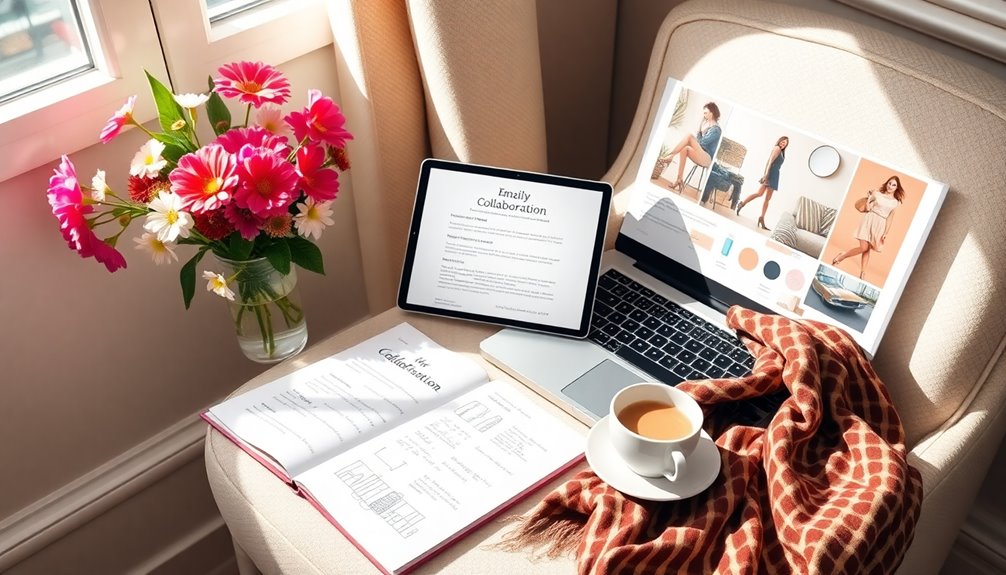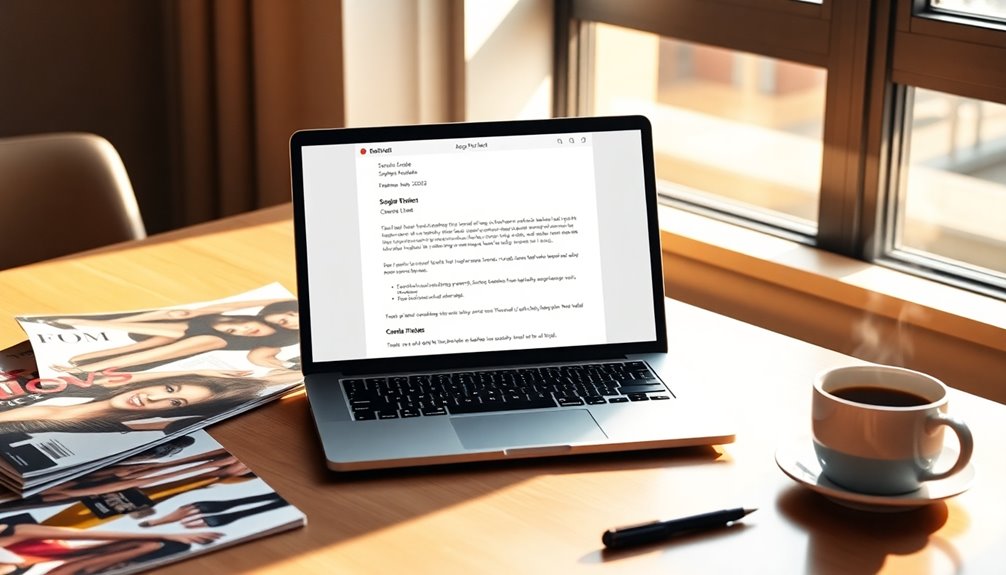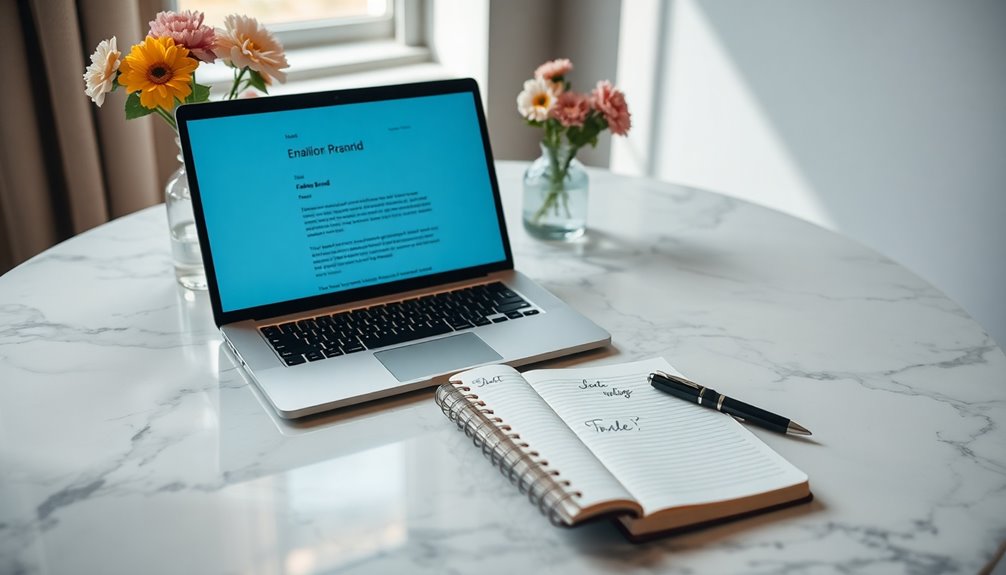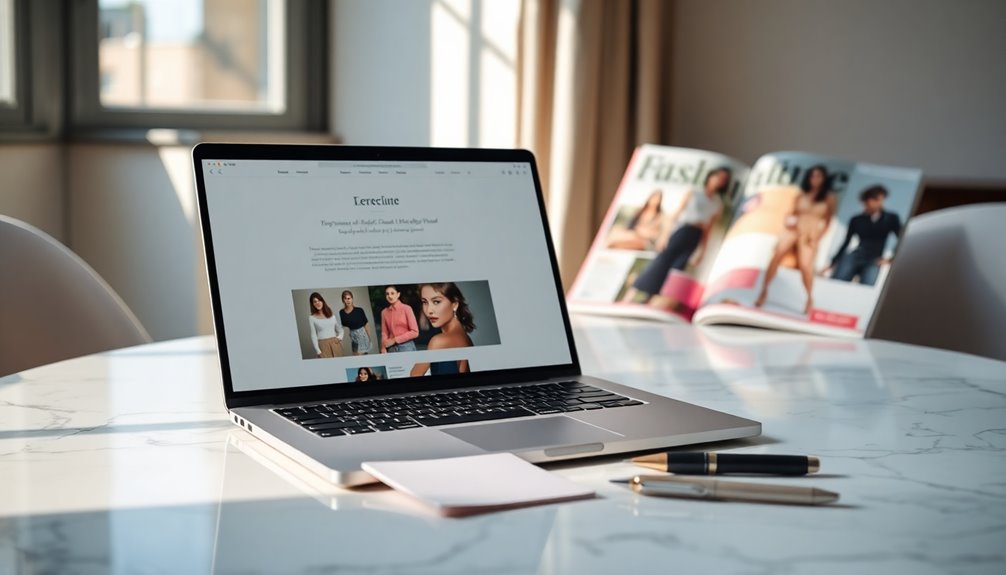To write a winning collaboration email to a fashion brand, start by personalizing your outreach and addressing them by name. Make sure to mention recent collections that resonate with their values. Clearly outline mutual benefits, like increased visibility and access to new audiences. Keep your subject line short and compelling, and follow up politely if you don't hear back. Want to reveal more tips and examples for a successful email strategy? Continue exploring!
Key Takeaways
- Personalize the email by addressing the brand by name and referencing their recent collections to show genuine interest.
- Clearly outline mutual benefits, such as increased visibility and access to new audiences, to highlight the value of collaboration.
- Use a clear, action-oriented subject line to convey the email's purpose and capture attention effectively.
- Incorporate metrics from past collaborations to demonstrate potential success and credibility in the partnership.
- Follow up politely within a week if there's no response, maintaining a positive tone to encourage engagement.
Understanding the Importance of Collaboration Emails

When you're reaching out to a fashion brand for collaboration, understanding the significance of your email can make all the difference.
A well-crafted collaboration email sample not only showcases your intent but also highlights mutual benefits for both parties. By incorporating personalization, you can considerably boost response rates and engage the recipient.
Clear communication of roles, expectations, and timelines helps streamline the workflow, fostering accountability. This sets the stage for a successful partnership that enhances brand awareness.
Don't underestimate the power of effective follow-up; it's essential for maintaining engagement and converting potential leads into successful collaborations.
Your outreach email should lay the groundwork for a meaningful connection that benefits everyone involved. Additionally, consider utilizing measurable goals to ensure both parties can track progress and success throughout the collaboration.
Key Elements to Include in Your Collaboration Email

When crafting your collaboration email, personalization and relevance are essential to catching the brand's attention.
Make sure your call to action is clear and compelling, guiding them on the next steps.
These elements can greatly increase your chances of a positive response.
Personalization and Relevance
To capture a fashion brand's attention, your collaboration email must be personalized and relevant. Start by tailoring your collaboration pitch to reflect the brand's values and target audience.
Show genuine interest by mentioning specific details about their recent collections or campaigns. This not only demonstrates knowledge but also enhances the relevance of your proposal.
Avoid generic email templates; instead, utilize AI tools to craft unique messages that resonate with the recipient. Highlight the mutual benefits of collaboration, like shared audience growth and increased brand visibility, to strengthen your case.
Additionally, consider referencing the brand's commitment to sustainable practices to align your proposal with their mission.
Finally, verify you have a clear subject line to grab attention, making it easy for the brand to see the value in your email.
Clear Call to Action
Craft a clear call to action (CTA) that guides the recipient toward the next steps in your collaboration proposal.
An effective email should specify what you want, like scheduling a meeting or requesting feedback. Direct CTAs can boost engagement and improve response rates considerably.
For example, say, "Let's schedule a call next week to discuss this collaboration further." This precise wording keeps the conversation focused and encourages timely responses.
Including a specific time frame also maintains momentum. Additionally, consider personalized CTAs that reference the brands' interests or past interactions, as this can enhance the likelihood of a positive response.
Remember to include your contact information, making it easy for them to reach out and start a mutually beneficial partnership.
Tips for Personalizing Your Outreach

Personalizing your outreach can greatly boost your chances of a successful collaboration with a fashion brand. Start by addressing the brand by name—emails that include the recipient's name in the subject line can increase open rates by 20%.
Research the brand's recent collections or campaigns, referencing them in your email to show genuine interest. Tailor your proposal to align with the brand's values and target audience, demonstrating how your collaboration can enhance their message.
Highlight specific metrics from past collaborations, like engagement rates or audience demographics, to showcase the value you bring. A personalized subject line reflecting your unique connection can also lead to a 30.5% increase in response rates, making your Email to a Brand stand out. Additionally, consider mentioning how your collaboration could promote essential oils for respiratory health, as this could resonate well with health-conscious consumers.
Crafting the Perfect Subject Line

How can a compelling subject line make or break your collaboration email? The subject line needs to grab the attention of your potential partner and entice them to open your message. Keep it short, ideally between 6-10 words, and use action-oriented language. For instance, "Let's Collaborate on a Unique Fashion Project!" clearly communicates your intention while sparking interest.
| Do's | Don'ts |
|---|---|
| Personalize with their name | Use generic phrases |
| Mention specific benefits | Make it vague |
| Test different subject lines | Ignore A/B testing |
Structuring Your Email for Maximum Impact

When you structure your email effectively, you increase the chances of capturing the brand's attention and sparking their interest in collaboration.
Start by crafting a compelling subject line that reflects your email's purpose. Follow this with a strong introduction, sharing a brief background about yourself and your connection to the brand.
Next, clearly define collaboration goals, highlighting the benefits of the collaboration for both parties. This aligns interests and showcases shared values.
Don't forget to include a strong call to action (CTA) that encourages a response, making it clear what you want the brand to do next.
Maintain a professional yet personal tone throughout, and wrap up with a polished email signature, making it easy for them to reach you.
Best Practices for Follow-Up Communication

When it comes to follow-up communication, timing is essential.
Sending a polite reminder within 3-5 days keeps the conversation alive and shows your genuine interest.
Timing Your Follow-Up
Although you might feel enthusiastic to get a response after sending your collaboration email, it's important to time your follow-up strategically.
Wait at least 3-5 business days before sending a follow-up email; this allows recipients enough time to review your proposal. Proper timing can boost your response rates by up to 30%, showcasing your interest without being overly aggressive.
In your follow-up, reference the original email and reiterate your key points to jog their memory. Consider offering a specific timeframe for a meeting or call to create a sense of urgency.
If you don't hear back after your second follow-up, it's wise to recognize disinterest and shift your focus to other potential partners, as persistent contact can feel intrusive.
Crafting Polite Reminders
To guarantee your follow-up email is effective, it's essential to keep it polite and concise. When you write a collaboration email, aim to send your follow-up emails within a week to maintain interest without being intrusive.
Include a polite reminder of your previous message and a clear call to action to prompt a response. Personalize your follow-up by referencing any relevant interactions, showcasing your genuine interest in a successful collaboration.
Limit your follow-up attempts to one or two to respect the recipient's time, while still demonstrating your enthusiasm. Use a positive tone throughout your communication to encourage dialogue and make your collaboration proposal more appealing.
This approach enhances your chances of a favorable reply.
Encouraging Further Engagement
Encouraging further engagement after your initial outreach can greatly enhance your chances of securing a collaboration. Send follow-up emails within a week to maintain momentum. Personalizing your message by referencing previous media can boost rapport. Use a clear call to action (CTA) to increase response rates. Remember that effective communication is key to fostering positive relationships.
| Action | Timing | Notes |
|---|---|---|
| Initial Email | Week 1 | Introduce collaboration and benefits. |
| Follow-Up #1 | Week 2 | Reiterate CTA; say you're a great match. |
| Follow-Up #2 | Week 3 | Respect their timeline; limit to two attempts. |
| No Response | After Two Emails | Please don't hesitate to explore other opportunities. |
Keep your contact info visible in all communications to facilitate easy replies.
Examples of Successful Collaboration Emails

Successful collaboration emails can make a significant difference in your outreach efforts. Start with a compelling subject line that grabs attention; remember, 47% of recipients decide to open based on this alone.
Personalize your email by mentioning previous interactions or shared interests, which can boost response rates by 30.5%. Include specific metrics about your audience demographics to enhance credibility and showcase the collaboration's potential impact.
Clearly outline mutual benefits for both brands, like increased visibility or access to new markets. Don't forget to attach a well-designed media kit that highlights your past successes and relevant statistics, providing valuable context for your pitch. Additionally, consider incorporating stress management techniques that can create a more balanced and productive work environment for both teams.
These elements can effectively support your collaboration email and improve your chances of success.
Frequently Asked Questions
How Do You Write an Email to a Brand for Collaboration?
To write an email to a brand for collaboration, start with a catchy subject line that grabs attention.
Introduce yourself briefly, mentioning your niche and relevant metrics to build credibility.
Clearly outline the mutual benefits of the collaboration, showing how it aligns with the brand's goals.
End with a strong call to action, like suggesting a follow-up meeting, and include a link to your media kit for more information.
How to Write an Email to Someone You Want to Collaborate With?
To write an email to someone you want to collaborate with, start with a friendly greeting and introduce yourself briefly.
Clearly state your collaboration idea and how it benefits both parties.
Use a catchy subject line to grab attention and make sure your call to action is straightforward, inviting them to respond or schedule a meeting.
Keep your tone professional but let your personality shine through to build rapport.
How to Pitch a Brand for Collaboration?
To pitch a brand for collaboration, start by researching the brand's values and audience.
Highlight how you align with their target market and can create engaging content together.
Personalize your approach by referencing specific details about their recent campaigns or products.
Don't forget to include a media kit showcasing your previous work and audience insights.
End with a strong call to action, suggesting a follow-up meeting to discuss potential opportunities.
How Do You Ask a Brand to Collaborate With You?
When you want to ask a brand to collaborate, start by expressing genuine interest in their products and values.
Show them you've researched their brand. Clearly explain how the partnership benefits both sides, emphasizing your audience's alignment with their target market.
Suggest tailored collaboration ideas that fit their marketing goals.
Finally, invite them to discuss the collaboration further, making it easy for them to connect with you.
Conclusion
In the world of fashion, your collaboration email is your calling card, opening doors to exciting partnerships. By incorporating the right elements and personal touches, you can create a compelling message that stands out. Remember, building relationships takes time, so don't hesitate to follow up. With each email, you're weaving a tapestry of connections that could lead to incredible opportunities. So, go ahead and craft that email—your next big collaboration might be just a click away!









